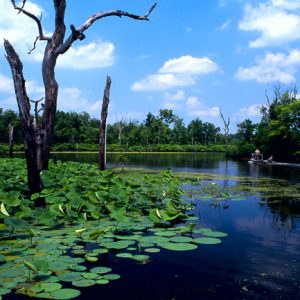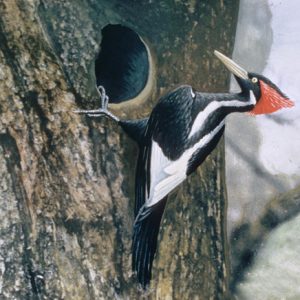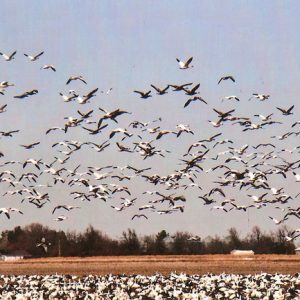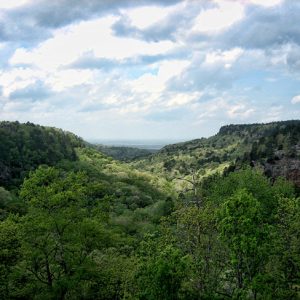calsfoundation@cals.org
Birdwatching
aka: Birding
Birdwatching, also commonly called birding, is the hobby of observing wild birds. Involvement in the pursuit ranges from enjoying birds on backyard feeders to traveling thousands of miles, nationally or internationally, to see new and different species. Birdwatching is usually considered to be distinct from ornithology, which is the scientific study of birds, although there is considerable overlap between the two.
Birdwatchers often keep records of when and where they saw different species. Many people keep records simply for the personal satisfaction of remembering interesting and unusual sightings. Records kept by amateur birdwatchers, however, have made significant contributions to ornithology by helping with the knowledge of bird distribution and abundance. Most birdwatchers keep a life list—a record of all the different species seen anywhere in the world—and many keep lists of bird species seen in their country, state, county, or back yard.
Arkansas offers a rewarding range of opportunities for birdwatchers. Seeing a variety of birds means visiting a variety of habitats, and, while Arkansas does not have a desert or a seacoast, the state’s landscape offers a diversity typical of its location in the south-central United States. Arkansas has hardwood and pine forests, scrubby fields, prairies, swamps, marshes, natural lakes, and large artificial reservoirs. This diversity provides homes for more than 140 species of nesting birds and a comparable number of wintering species. Arkansas’s location on the Central Flyway means that many additional species pass through the state in spring and fall on their way to and from breeding grounds to the north and wintering grounds to the south.
A total of around 400 species have been seen in Arkansas, although many of those are either extinct or extirpated (found elsewhere but no longer in the state) or are extreme rarities that have been seen only once or a few times. Well over 300 species can be found with some regularity in Arkansas over the course of a year.
The number of active birdwatchers in Arkansas has greatly increased in recent years, adding to the knowledge of when and where birds are found in the state. In addition, the Internet has tremendously facilitated the sharing of information. A listserv maintained by the University of Arkansas (UA) in Fayetteville (Washington County)—ARBIRD-L, the Birds of Arkansas Discussion List—provides updates on sightings of rare birds. A free online program called eBird, sponsored by the Cornell Lab of Ornithology and the National Audubon Society, lets birders enter a variety of data on sightings and contribute to a worldwide database while securely storing their personal records.
The Arkansas Audubon Society collects records of birds seen in Arkansas and holds meetings in the spring and fall featuring lectures and field trips. The society website offers downloadable checklists of Arkansas birds and other information. In addition, there are several local chapters of the National Audubon Society in Arkansas, all of which offer regular meetings and field trips.
Arkansas is home to nesting species that are especially sought by birdwatchers from other parts of the country. The endangered red-cockaded woodpecker is found only in mature stands of pine in the southeastern United States and can be seen in several places in Arkansas, including Felsenthal National Wildlife Refuge west of Crossett (Ashley County) and the Buffalo Road Demonstration Area south of Waldron (Scott County). Brown-headed nuthatches and Bachman’s sparrows, two other pine specialists, can be found widely across southern Arkansas. The painted bunting, regarded as one of America’s most beautiful birds, is widely distributed in shrubby areas and old fields across the state. Smith’s longspur, a grassland species with a very limited range, regularly winters at the Stuttgart (Arkansas County) airport.
Bird distribution in Arkansas has changed in many ways over recent decades. Much natural habitat has been lost to agriculture, timber practices, and urbanization. Several species associated with the southwestern region have become more common, probably because of land clearing and changing climate. These species include black-bellied whistling-duck, greater roadrunner, scissor-tailed flycatcher, and great-tailed grackle. Other species that have increased in number in the state include the bald eagle, Cooper’s hawk, Eurasian collared-dove, western kingbird, and cliff swallow.
In 2005, and for a few succeeding years, thousands of birdwatchers came to eastern Arkansas because of reported sightings of the ivory-billed woodpecker, a species that most ornithologists believed had been extinct for decades. The validity of the sightings was a subject of great controversy, with many scientists and top birding experts expressing doubt. After the initial alleged sightings, there have been no further serious reports of the species.
Birdwatching Locations
Large reservoirs such as Millwood, Ouachita, Greers Ferry, and Beaver lakes provide a winter home for ducks and other waterbirds, such as loons and grebes. In addition, the once-endangered bald eagle has made a comeback since the 1980s and now can be found nesting along the shorelines of many Arkansas lakes and rivers.
Arkansas is home to ten national wildlife refuges operated by the U.S. Fish and Wildlife Service. Several of these are excellent birdwatching locations, including Big Lake west of Blytheville (Mississippi County), Wapanocca near Turrell (Crittenden County), Felsenthal west of Crossett, and Holla Bend east of Dardanelle (Yell County). All these are good places to look for wintering waterfowl as well as a variety of nesting birds in spring and summer. Bald Knob National Wildlife Refuge, south of Bald Knob (White County), is noted for flocks of shorebirds (such as sandpipers and plovers) and wading birds (such as herons, egrets, and storks) from spring through fall.
Arkansas’s two major national forests, Ozark and Ouachita, offer miles of hiking trails and little-traveled gravel roads, providing access to hardwood and pine woodlands. Exploring these public lands in spring and early summer offers the chance to see many of the state’s breeding songbirds, including vireos, warblers, and tanagers, as well as wild turkeys and several species of hawks and owls.
The Arkansas Game and Fish Commission operates more than 100 wildlife management areas (WMAs) around the state. Although primarily set aside as public hunting and fishing areas, many of these can also be productive areas for birdwatching. Some of the better birding areas include Bayou Meto south of Stuttgart, Bell Slough south of Conway (Faulkner County), Grandview Prairie west of Hope (Hempstead County), Dagmar west of Brinkley (Monroe County), and St. Francis Sunken Lands southeast of Jonesboro (Craighead County). Care should be taken when visiting in hunting seasons, especially deer season; parts of many of these areas are closed in waterfowl season.
Many of Arkansas’s state parks offer stellar birdwatching. A few options are Devil’s Den south of Fayetteville, Hobbs east of Rogers (Benton County), Mount Magazine south of Paris (Logan County), Petit Jean south of Morrilton (Conway County), Pinnacle Mountain west of Little Rock (Pulaski County), Queen Wilhelmina west of Mena (Polk County), and Village Creek north of Forrest City (St. Francis County).
Several natural areas, administered by the Arkansas Natural Heritage Commission and/or the Game and Fish Commission and other agencies, are productive for birdwatching. Especially noteworthy are the areas that preserve native prairie, a rare habitat in the state. Such sites include Roth Prairie near Stuttgart, as well as H. E. Flanagan Prairie and Cherokee Prairie, both near Charleston (Franklin County). Henslow’s sparrow, a rare nesting bird in Arkansas, can be found at Cherokee and Flanagan prairies. Wintering short-eared owls are often spotted in prairies. Pine City Natural Area east of Clarendon (Monroe County) is home to endangered red-cockaded woodpeckers. Striplin Woods Natural Area, within the Dale Bumpers White River National Wildlife Refuge east of St. Charles (Arkansas County), protects a mature bottomland hardwood forest, excellent for birdwatching in spring migration.
Other fine birding locations in Arkansas include Craighead Forest Park in Jonesboro, which has many birds during spring migration but has also attracted rare birds in fall and winter. Lake Fayetteville, a green oasis in the northwestern Arkansas metropolitan area, is home to wintering waterfowl and has trails with year-round birding opportunities. Lake Wedington west of Fayetteville is another productive location year-round. Near Siloam Springs (Benton County), Chesney Prairie is a fragment of the original tallgrass prairie that was once far more extensive in the region. The grassland here is home to a variety of wintering hawks, owls, wrens, and sparrows. Dams along the Arkansas River attract gulls and American white pelicans from fall through spring. In spring and fall, spending time watching along the river can bring sightings of ospreys, bald eagles, gulls, terns, and other species following the river in migration.
The Arkansas Game and Fish Commission operates several state fish hatcheries, which attract ducks, wading birds, and shorebirds from fall through spring. Three popular birding locations are Joe Hogan Hatchery near Lonoke (Lonoke County), Andrew Hulsey Hatchery on the south shore of Lake Hamilton near Hot Springs (Garland County), and Charlie Craig Hatchery near Centerton (Benton County).
Lake Dardanelle, near Russellville, hosts loons, grebes, and waterfowl, as do other large reservoirs, but its location on the Arkansas River allows it to host a large number of rare birds in winter, including ducks and gulls seldom seen elsewhere in the state. In addition, Arkansas Post National Memorial, north of Dumas (Desha County), has wetlands that are home to anhinga, pied-billed grebe, common moorhen, purple gallinule, least bittern, and other marsh and swamp species.
For additional information:
Arkansas Audubon Society. http://www.arbirds.org (accessed September 7, 2021).
James, Douglas A., and Joseph C. Neal. Arkansas Birds. Fayetteville. University of Arkansas Press, 1986.
Butler, Jerry.”A Rare Bird Indeed.” Arkansas Democrat-Gazette, December 7, 2020, pp. 1D, 6D.
———. “Where the Birds Are.” Arkansas Democrat-Gazette, September 9, 2019, pp. 1D, 6D.
White, Mel. A Birder’s Guide to Arkansas. Delaware City: American Birding Association, 1995.
———. “Ghost Bird.” National Geographic (December 2006): 142–157.
Mel White
Little Rock Arkansas
 Science and Technology
Science and Technology Thomas, Ruth Harris
Thomas, Ruth Harris Beaver Lake
Beaver Lake  Felsenthal National Wildlife Refuge
Felsenthal National Wildlife Refuge  Ivory-billed Woodpecker
Ivory-billed Woodpecker  Mississippi Flyway
Mississippi Flyway  Petit Jean State Park View
Petit Jean State Park View  Red-cockaded Woodpecker
Red-cockaded Woodpecker 




Comments
No comments on this entry yet.